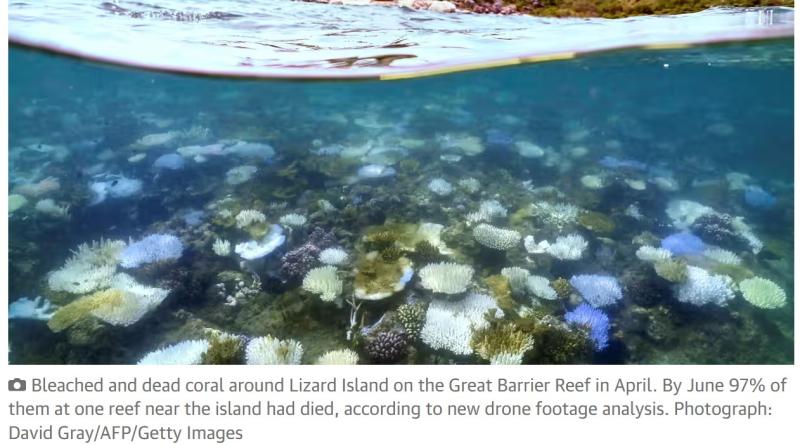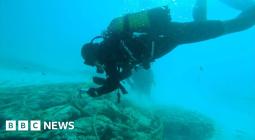‘Most of it was dead’: scientists discover one of Great Barrier Reef’s worst coral bleaching events

At least 97% of corals on a reef in the Great Barrier Reef’s north died during one of the worst coral bleaching events the world’s biggest reef system has ever seen, according to new analysis.
Scientists at several institutions used high-resolution drone imagery to track the bleaching and death of corals on a reef at Lizard Island.
It comes as Unesco urged the federal government to publicly release data “as soon as possible” on how much coral died during last summer’s mass bleaching.
The analysis is understood to be the first attempt to quantify the extent of coral death over a reef affected by this summer’s mass bleaching – the fifth in eight years – that saw heat stress hit record levels across some parts of the world heritage-listed reef.
“I was horrified,” said Macquarie University marine biologist Prof Jane Williamson, who worked with colleagues to analyse the mass coral death at Lizard Island’s North Point reef.
On Tuesday the environment minister, Tanya Plibersek, declared a “huge win” for Australia after Unesco said it would not recommend the world heritage committee put the reef on its list of sites “in danger” when it meets at the end of July in India.
But Unesco urged the government to improve its climate targets and reduce land clearing, saying the full extent of the damage from this summer’s bleaching, including the number of corals that perished, was not yet known.
“[Australia] is urged to make mortality rates public as soon as possible,” the Unesco report said.
Williamson and colleagues analysed drone footage taken over the Lizard Island reef in March, which showed evidence of widespread bleaching and fluorescing – a phenomenon when corals release a spectacular pigment into their flesh as a sign of heat stress.
Flying a drone over the same section of reef earlier this month to match the images, Williamson said: “At least 97% of the corals had died over those three months.
“We were there to do our sea cucumber monitoring work, but there was silence amongst us nine researchers.
“We came out of the water and didn’t know what to say. It’s an iconic reef and most of it was dead.”
A/Prof Karen Joyce, of James Cook University, said she had been mapping coral for 25 years. “It’s devastating to say that this year, my job became so much easier. In the small area we analysed, instead of many thousand live corals, I can count the few remaining on my fingers.”
Dr Lyle Vail, the director of the Australian Museum’s Lizard Island Research Station, said until this summer the reef at North Point was “truly amazing” and had recovered well from a major bleaching event in 2016.
“It’s pretty heartbreaking to lose all that coral recovery,” he said.
In a journal this week, scientists from the Australian Institute of Marine Science, James Cook University and the Great Barrier Reef Marine Park Authority released research showing corals were now getting less time to recover from cyclones, bleaching and outbreaks of native coral-eating starfish.
After looking at the results of coral monitoring trips across 131 reefs over more than 30 years, the scientists found the number of reefs hit by disturbances had gone up from 6% in the 1980s to 44% in the 2010s.
The frequency of coral bleaching had increased between 19% and 38% a year, and cyclone damage had also risen slightly, “resulting in less time for recovery”.
“These results confirm that climate change is contributing to ecosystem-wide changes in the ability of coral reefs to recover,” the research said.
The marine park authority said it had given accurate updates throughout the summer but it would take time to determine the impacts on corals as events “play out over many months”.
A statement said: “The duration of the environmental conditions and the coral species found on each reef will determine the amount of mortality, survival and recovery on affected reefs.
“What we are seeing now is variable across the Great Barrier Reef – some corals have died from the coral bleaching event – but we are also starting to see recovery, even in areas that were badly bleached.”
The Australian Institute of Marine Science’s long-term monitoring program will release its annual report on coral reef conditions later this year, the statement said.





